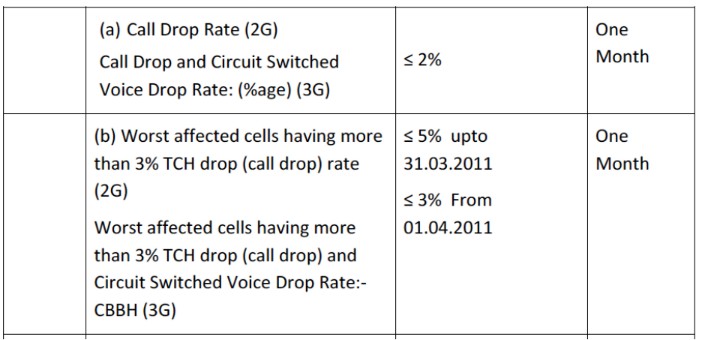[orc]The Parliamentary Standing Committee on Information Technology submitted a report on the issue of call drops and recommended that the Quality of Service parameters including call drop rate be measured at a more granular level.
The Parliamentary Standing Committee on Information Technology submitted its 38th report recently on the issue of ‘Quality of Service & Reported Call Drops’. Among other things, the committee felt that the current way of measuring ‘Quality of Service (QoS)’ parameters is not adequate to identify problematic areas and recommended that TRAI come up with a new set of QoS parameters to measure them at a more granular level including the rate of call drops.
The issue of ‘Call Drops’
TRAI had laid down QoS benchmarks to measure various parameters including call drop rate. For call drops, the current benchmark is ≤ 2% for both 2G & 3G while the bench mark for worst affected cells is ≤ 3%. These are measured for the service area as a whole and averaged for a quarter. These regulations were amended in 2015 to increase the financial disincentive component for any violation of the QoS benchmark. 
Reasons for Call Drops – Who said what?
In their submission to the standing committee, various stakeholders cited different reasons for call drops. The Department of Telecom (DoT) mentioned the following reasons for call drops.
- Poor radio coverage
- Non availability of suitable tower-locations due to acquisition problems
- Sealing of towers by local authorities/ RWA/ Owners due to EMF/ Other issues
- Clearance by Government
- Radio interference due to unauthorized use of repeaters/ Wi-Max frequencies/ at international borders.
- Change in pattern of traffic: exponential growth in data traffic due to more use of smart phones which results in Shrinkage of 3G/ 4G cell size.
- Loading of available spectrum
- Limited spectrum with very high users
- Towers too close to each other in same band causes interference in 3G/ 4G
- Non availability of 24×7 power resulting in shutdown of towers
- Poor RF optimization
- Up-gradation of network maintenance tools to International standards
- Inadequate investment in Network causing capacity constraints.
On the other hand, TRAI mentioned the following reasons in addition to what the DoT cited.
- Handover failure due to congestion, coverage issues, traffic imbalance between two cell sites and wrong network configuration or wrong neighbour definition
- Co-channel and adjacent channel frequency interference
- Transmission problems due to faulty transceiver (TRX) within the base station or faulty transmission media
- Hardware related issues, including equipment failure
- High difference between uplink signal and downlink signal level due to high transmit power of the BTS, malfunction of the Tower mounted amplifier or BTS amplifier,
- Deficient spectrum availability or non-installation of BTSs by the service providers in keeping up with the growth of the subscriber base
Cellular Operators Association of India (COAI) in their submission classified the call drop scenarios into 4 types. In other words, COAI said that the first three types of call drop scenarios are beyond their control.
So what did the Standing Committee recommend?
On the issue of call drops, the standing committee put forth a set of recommendations for various stake holders after going through their submissions.
Measure Call drops at a more granular level: The Committee felt that there are critical gaps in QoS parameters. The committee also felt that QoS parameters should be measured at more micro granular level, such as at Secondary Switching Area (SSA) level or at district/city level or at Short Distance Charging Area (SDCA) level, BTS level, etc. This, the committee felt would give a realistic assessment of call drops and also provide detailed information about areas where the performance is poor. The committee recommended that TRAI revise its QoS parameters and a new set of parameters be framed, so that coordinated action could be taken to address areas with issues.
Complete consultation on Call Drops in a time bound manner: In their submission to the committee, the telecom service providers in general were not in favour of shifting the measurement from service area to sub-service area level and cited numerous reasons, such as factors beyond TSPs control, no international reference of sub-service area level bench-marking comparable to India, lack of availability of digital maps with clearly defined towns, etc. Hence the committee recommended that TRAI examine the method of measurement of call drop carefully so that better measurement parameters are adopted. The committee also recommended that the consultation on measurement of call drop be completed in a time bound manner and that the committee is kept informed of the outcome.
Constructive partnership needed to resolve the issue of call drops: The committee felt that all stakeholders including the consumers should come together in unison and build a constructive partnership to address the issue of call drops as the reasons are many. The Committee recommended that the government review the status of remedial measures taken at regular intervals.
Educate Customers: As per TRAI’s technical paper on call drops, 36.9 per cent of call drops is because of the consumer’s fault, the second largest cause. Since there are no guidelines to educate consumers about irregular user behaviour that can cause call drop, the Committee recommended that necessary information be compiled in both the national and major regional languages for the benefit of the consumers and consumers be educated through awareness campaigns.
Other recommendations: The committee also made other recommendations like strict implementation of BIS standards for all handsets to prevent sub-standard handsets from getting into the markets. The committee also recommended that the TRAI act be amended to empower it with punitive powers for implementing the QoS benchmarks. The committee also felt that public should be made aware to allay the fears of consumers and Residence Welfare Associations (RWAs) about EMF Radiation.



1 Comment
Visit us to know Thai Lottery King VIP Total & Direct Sets 16 June 2017